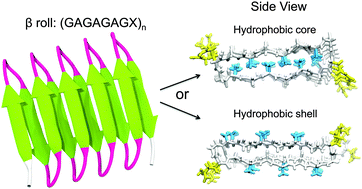Dock ‘n roll: folding of a silk-inspired polypeptide into an amyloid-like beta solenoid
Abstract
Polypeptides containing the motif ((GA)mGX)n occur in silk and have a strong tendency to self-assemble. For example, polypeptides containing (GAGAGAGX)n, where X = G or H have been observed to form filaments; similar sequences but with X = Q have been used in the design of coat proteins (capsids) for artificial viruses. The structure of the (GAGAGAGX)m filaments has been proposed to be a stack of peptides in a β roll structure with the hydrophobic side chains pointing outwards (hydrophobic shell). Another possible configuration, a β roll or β solenoid structure which has its hydrophobic side chains buried inside (hydrophobic core) was, however, overlooked. We perform ground state analysis as well as atomic-level molecular dynamics simulations, both on single molecules and on two-molecule stacks of the silk-inspired sequence (GAGAGAGQ)10, to decide whether the hydrophobic core or the hydrophobic shell configuration is the most stable one. We find that a stack of two hydrophobic core molecules is energetically more favorable than a stack of two hydrophobic shell molecules. A shell molecule initially placed in a perfect β roll structure tends to rotate its strands, breaking in-plane hydrogen bonds and forming out-of-plane hydrogen bonds, while a core molecule stays in the β roll structure. The hydrophobic shell structure has type II′ β turns whereas the core configuration has type II β turns; only the latter secondary structure agrees well with solid-state NMR experiments on a similar sequence (GA)15. We also observe that the core stack has a higher number of intra-molecular hydrogen bonds and a higher number of hydrogen bonds between stack and water than the shell stack. Hence, we conclude that the hydrophobic core configuration is the most likely structure. In the stacked state, each peptide has more intra-molecular hydrogen bonds than a single folded molecule, which suggests that stacking provides the extra stability needed for molecules to reach the folded state.


 Please wait while we load your content...
Please wait while we load your content...